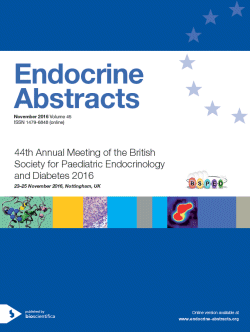
44th Meeting of the British Society for Paediatric Endocrinology and Diabetes
Poster Presentations
Miscellaneous/other
ea0045p46 | Miscellaneous/other | BSPED2016
Blood pressure monitoring and management in young girls with turner syndrome
Murtaza Mohammed Ibrar , Anderson Ellen , Leighton Emma , Wong Sze Choong , Mason Avril
ea0045p47 | Miscellaneous/other | BSPED2016
Longitudinal changes in bone density and body composition in post-pubertal adolescents treated with GnRH analogues in a Gender Identity Development Service
Tseretopoulou Xanthippi , Alvi Sabah , Avatapalle Bindu , Walker Jenny , Carruthers Paul , Mushtaq Talat
ea0045p48 | Miscellaneous/other | BSPED2016
Ketotic hypoglycaemia in children with transient congenital hyperinsulinism of infancy
Giri Dinesh , Patil Prashant , Yung Zoe , Didi Mohammed , Senniappan Senthil
ea0045p49 | Miscellaneous/other | BSPED2016
Vitamin D status of healthy, low-income, kurdish children in Sulaimani city and Kalar district of Iraqi Kurdistan
Mohammad Dereen Najat , Ali Mohammed Abdalqadir , Mohammed Nwayyin
ea0045p50 | Miscellaneous/other | BSPED2016
Hyperinsulinaemia: Demographics of cases in a district general hospital over a 5 year period
Losa Ignatius , Sudarsanan Sunanda , Ghauri Rooha
ea0045p51 | Miscellaneous/other | BSPED2016
Altered islet architecture in congenital hyperinsulinism in infancy
Mal Walaa , Salomon-Estebanez Maria , Han Bing , Padidela Raja , Skae Mars , Craigie Ross , Cosgrove Karen , Banerjee Indi , Dunne Mark
ea0045p52 | Miscellaneous/other | BSPED2016
Enhanced islet cell neogenesis and endocrine cell differentiation are pathognomonic with congenital hyperinsulinism in infancy
Hardwick Elise , Han Bing , Salomon-Estebanez Maria , Padidela Raja , Skae Mars , Craigie Ross , Cosgrove Karen , Banerjee Indi , Dunne Mark
ea0045p53 | Miscellaneous/other | BSPED2016
Vineland adaptive behaviour scales to identify neurodevelopmental problems in children with Congenital Hyperinsulinism (CHI)
Mohamed Zainaba , Banerjee Indraneel , Michaelidou Maria , Estabanez Maria , Dunne Mark J , Collins Hannah , Rigby Lindsey , Bowden Louise , Rust Stewart , Nicholson Jacqueline
ea0045p54 | Miscellaneous/other | BSPED2016
The profiles of insulin secretory granules are markedly different in β-cells of patients with either focal or diffuse Congenital Hyperinsulinism in Infancy (CHI)
Han Bing , Mohamed Zainab , Salomon-Estebanez Maria , Padidela Raja , Skae Mars , Craigie Ross , Cosgrove Karen , Banerjee Indi , Dunne Mark
ea0045p55 | Miscellaneous/other | BSPED2016
Flash glucose monitoring in children with congenital hyperinsulinism; first report on accuracy and patient experience
Alsaffar Hussain , Turner Lucy , Yung Zoe , O'Hara Cheryl , Didi Mohammed , Senniappan Senthil
ea0045p56 | Miscellaneous/other | BSPED2016
Doubtful efficacy of Sirolimus in the treatment of patients with severe congenital hyperinsulinism
Estebanez Maria Salomon , Han Bing , Padidela Raja , Mosinska Karolina , Stevens Adam , Dunne Mark , Banerjee Indi
ea0045p57 | Miscellaneous/other | BSPED2016
New histological characterisation of focal lesions and clinical implications
Estebanez Maria Salomon , Craigie Ross , Han Bing , Mal Walaa , Mohammed Zainab , Newbould Melanie , Cheeseman Edmund , Bitetti Stefania , Rigby Lindsey , Banerjee Indi , Dunne Mark
ea0045p58 | Miscellaneous/other | BSPED2016
Assessing impact of the provision of accessible information to families with Congenital Hyperinsulinism (CHI)
Trimarco Lauren , Banerjee Indi , Rigby Lindsey , Bowden Louise , Estebanez Maria Salomon , Cosgrove Karen , Nicholson Jacqueline
ea0045p59 | Miscellaneous/other | BSPED2016
Generalised lipodystrophy as a rare presentation of a hypothalamic tumour
Estebanez Maria Salomon , Douzgou Sofia , Fedee Joanne , Semple Robert , Skae Mars



